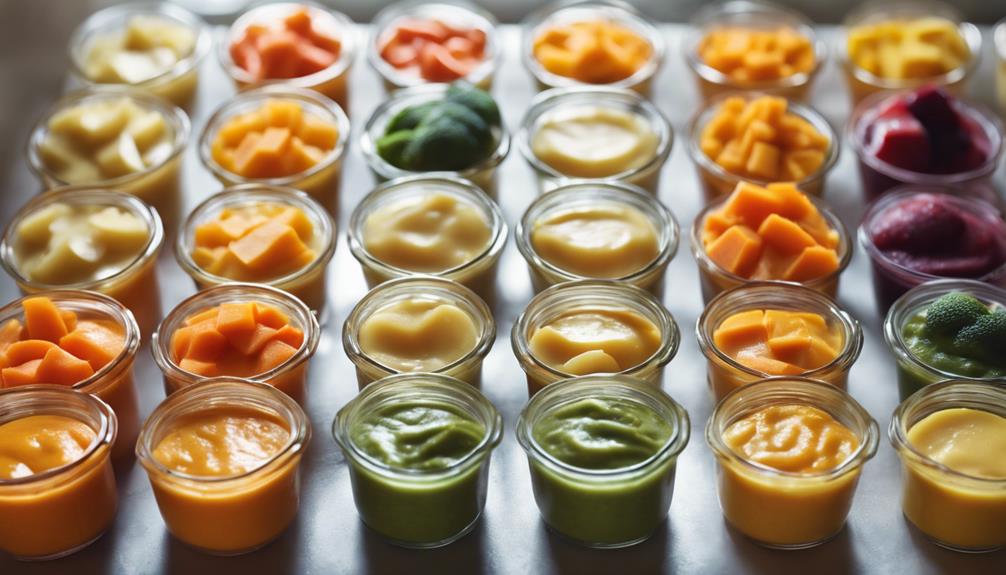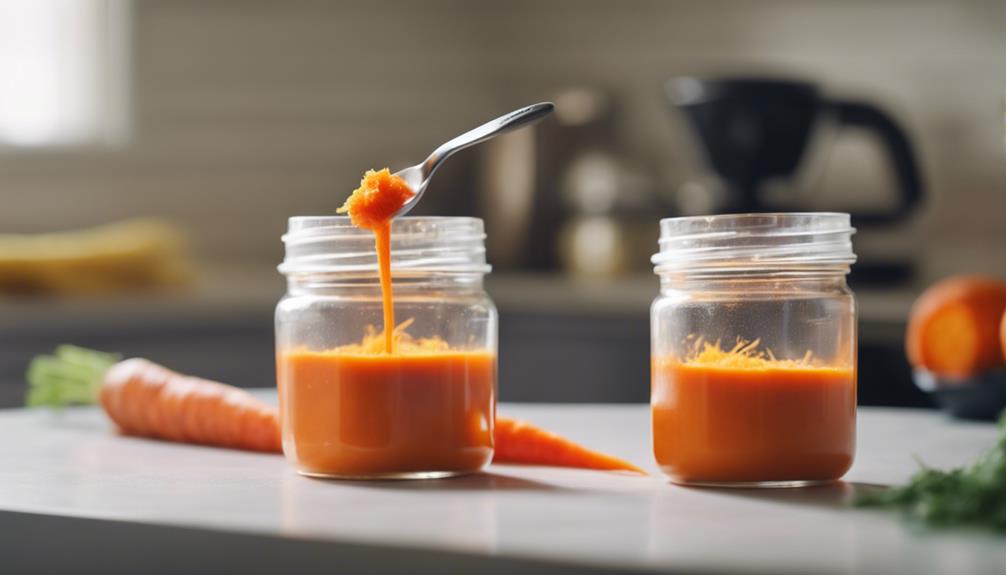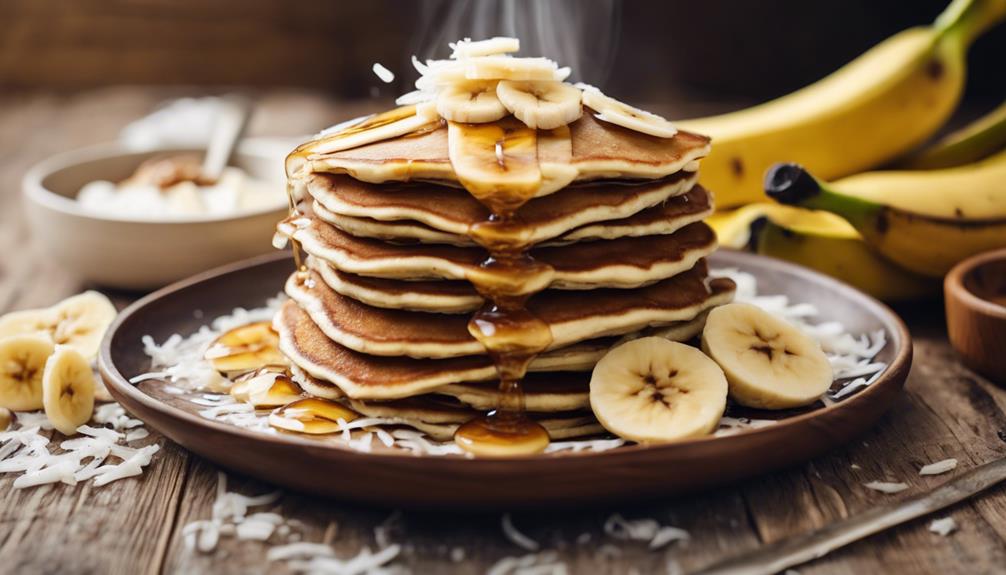Are you ready to excite your little one’s taste buds? Butternut squash baby puree combinations are not only tasty but also full of essential nutrients for your baby’s development. This versatile vegetable can be paired beautifully with fruits, vegetables, and proteins. Mix until smooth, adjusting the texture based on your baby’s age. Add liquid to reach the desired consistency. Get creative with combinations like apples, pears, spinach, or sweet potatoes. By making homemade purees, you can avoid additives and experiment with spices such as cinnamon or ginger. Butternut squash provides a gateway to a variety of flavorful and nutrient-rich baby food options.
Key Takeaways
- Blend butternut squash with apples and pears for a sweet and nutritious combination.
- Mix in spinach and kale to boost vitamins and minerals in your baby's diet.
- Combine with pasta, rice, or baby cereals for varied textures and flavors.
- Introduce colorful veggies like carrots, sweet potatoes, and peas for a diverse nutrient intake.
- Pair with fruits and vegetables to create a balanced and nutrient-rich puree for your baby.
Nutrient-Rich Butternut Squash Benefits
Discover the nutrient-rich benefits of butternut squash for your baby's growth and development. Butternut squash is a powerhouse of essential nutrients like vitamin A, important for promoting healthy skin, eyesight, and immune function in infants.
Additionally, the fiber content in butternut squash aids in digestion and promotes regular bowel movements for your little one. This nutritious vegetable is a fantastic choice for creating delicious and wholesome baby purees that your baby will love.
By incorporating butternut squash into your baby's diet early on, you can help establish a preference for nutrient-dense foods, setting the stage for a lifetime of healthy eating habits. With its versatility, butternut squash can be easily combined with a variety of fruits, vegetables, and proteins to create a balanced and flavorful meal for your baby.
Buying & Storing Butternut Squash
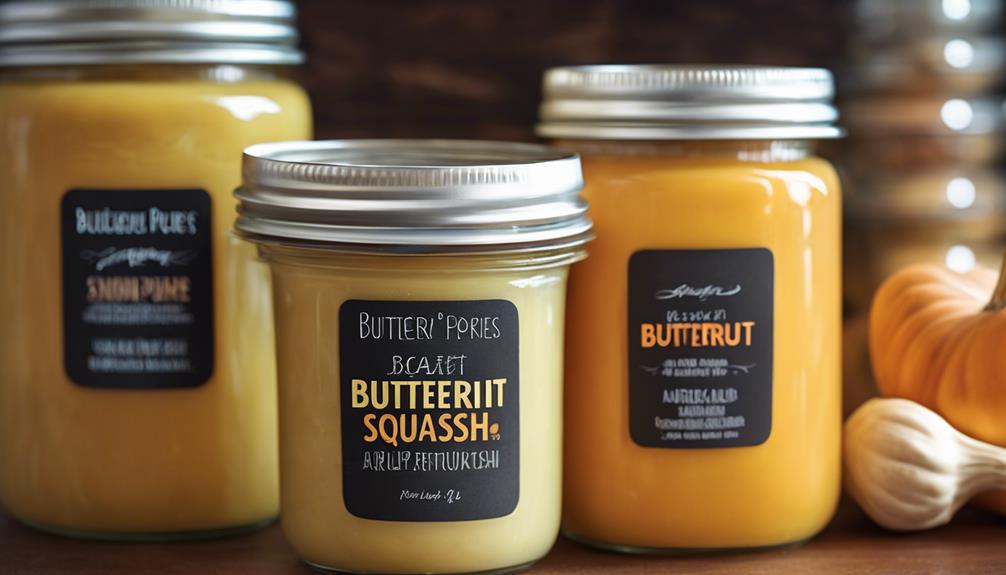
When buying butternut squash, look for ones that are heavy, firm, and free of cuts or bruises to guarantee freshness.
Remember to store your whole butternut squash in a cool, dark place instead of refrigerating it to maintain its quality.
Purchasing Butternut Squash
To guarantee freshness and quality when purchasing butternut squash, opt for a heavy, firm squash free of cuts or bruises. Butternut squash is a versatile and nutritious food choice for your baby's puree recipes. It's available year-round but truly shines during fall and winter when it's in peak season, offering the best flavor and nutritional value.
When shopping, consider selecting precut butternut squash cubes for added convenience, ensuring they're fresh and free from spoilage. Remember to store whole butternut squash in a cool, dark place, as refrigeration isn't necessary and can impact its taste and texture. Properly stored, this delicious ingredient can last for several weeks, allowing you to enjoy its benefits and versatility over an extended period.
Storing Butternut Squash
Wondering how to best store butternut squash for peak freshness and flavor in your baby puree recipes?
To maintain peak freshness and guarantee your squash retains its nutrients, store whole butternut squash in a cool, dark place. No need to clutter up your fridge; just find a nice spot away from direct sunlight.
Remember, when selecting your squash, pick one that feels heavy, firm, and free of any cuts or bruises. This will guarantee that your squash stays fresh for weeks, giving you a reliable supply for your baby's meals.
Cooking Butternut Squash for Puree

When cooking butternut squash for puree, you have a variety of methods to choose from, such as baking, steaming, microwaving, or using an Instant Pot. Each method requires different preparation steps, like slicing, peeling, or cutting the squash before cooking it until soft and ready for blending.
Cooking Methods
Consider various cooking methods such as baking, steaming, microwaving, or using an Instant Pot when preparing butternut squash for baby puree. Each method offers a unique way to cook the squash, bringing out different flavors and textures that can appeal to your little one's taste buds.
Here are some fun ways to cook butternut squash for your baby puree:
- Baked Butternut Squash: Slice the squash, roast it at 400°F for 30-40 minutes, and enjoy the caramelized sweetness that baking brings out.
- Steamed Butternut Squash: Peel, chop, and steam the squash until soft, typically around 10 minutes, preserving its natural flavors and nutrients.
- Microwaved Butternut Squash: Cut the squash into pieces, microwave on high for 8-10 minutes, for a quick and easy cooking method that retains the squash's vibrant color and taste.
Experiment with these methods to find the one that suits your baby's palate the best!
Preparation Tips
For optimal outcomes when cooking butternut squash for puree, make sure to properly prepare the squash using the recommended methods. Whether you choose to bake, steam, microwave, or use an Instant Pot, the key is to guarantee the squash is cooked until tender for a smooth puree texture.
When making butternut squash baby food, consider roasting the squash by slicing it, roasting at 400°F for 30-40 minutes, and scooping out the flesh for a caramelized flavor profile. Alternatively, you can opt for steaming by peeling, chopping, and steaming the squash until soft, which helps retain more nutrients.
Whichever method you choose, remember to blend the cooked squash using a blender or food processor until it reaches a creamy consistency. To store the puree, use airtight storage containers and freeze any unused portions for later use.
Experiment with different cooking techniques to find the one that suits your baby's taste preferences best!
Blending Butternut Squash Smoothly
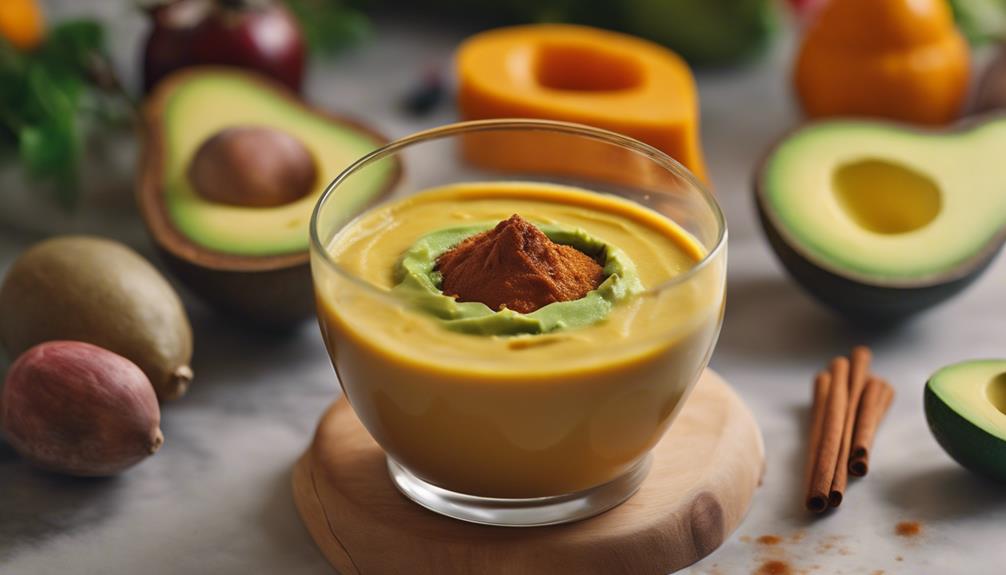
To blend butternut squash smoothly, make sure it's cooked until soft before using a blender to achieve a creamy consistency.
When preparing your baby's puree, follow these tips for a hassle-free blending experience:
- Blend in Small Batches: Working in small batches guarantees better control over the texture and helps you achieve a smoother result without overwhelming your blender.
- Adjust Blending Time: Depending on your baby's age and preferred texture, adjust the blending time to achieve the perfect smoothness for their stage.
- Add Liquid for Consistency: For a velvety puree, add a splash of water, breast milk, or formula to reach the desired consistency and make the blending process easier.
Utilizing Butternut Squash Puree

When it comes to utilizing butternut squash puree, the possibilities are endless.
You can create flavorful pairings by combining it with fruits, vegetables, or proteins.
Not only does it boost the nutrient content of your baby's meals, but its versatility in recipes like muffins or pasta sauce adds a delicious twist to mealtime.
Flavorful Pairings
Enhance the taste of butternut squash puree by combining it with a variety of complementary ingredients like fruits, vegetables, and protein sources. Mixing these different elements can create delicious and nutritious meals for your baby.
Here are some flavorful pairings to try out:
- Fruit Combinations: Blend butternut squash with apples, pears, or berries to add a sweet twist to the puree that your baby will love.
- Vegetable Mixes: Incorporate carrots, sweet potatoes, or spinach into the butternut squash puree for added flavors and a boost of nutrients.
- Protein Infusions: Add chicken, turkey, or lentils to the puree to make it more filling and balanced, providing your little one with essential proteins.
These combinations not only introduce various tastes to your baby but also offer a range of nutrients essential for their growth and development.
Don't be afraid to get creative and experiment with different pairings to find what your baby enjoys the most!
Nutrient Boost
By combining butternut squash puree with a variety of nutritious ingredients, you can create meals that offer a significant nutrient boost for your baby's growth and development. Butternut squash is a nutrient-dense option, packed with essential vitamins and minerals important for your baby's well-being.
Mixing it with fruits like apples or pears not only enhances the flavor but also provides a diverse range of nutrients. Introducing protein sources such as chicken or lentils to butternut squash puree can elevate the meal's nutritional value, supporting your baby's growth.
Don't be afraid to add a sprinkle of spices like cinnamon, ginger, or mild curry powder to the puree to introduce new flavors and expand your baby's palate. Experiment with combinations like butternut squash puree with spinach or kale to make sure your baby receives a wide variety of nutrients necessary for their development.
Get creative and watch your little one enjoy these nutrient-packed meals!
Recipe Versatility
Consider incorporating butternut squash puree into a variety of baby food recipes to explore a range of flavors and nutrients for your little one. When it comes to recipe versatility, the options are endless. Here are some delicious ideas to get you started:
- Mix butternut squash puree with fruits like apples, pears, and berries for a sweet and tangy twist.
- Combine it with veggies such as carrots and spinach to add a savory depth to your baby's meal.
- Enhance the nutritional value by adding proteins like chicken or lentils to the butternut squash puree for a protein-packed meal.
Don't be afraid to experiment with spices like cinnamon, ginger, or mild curry to elevate the flavor profile of your baby's food.
Get creative with combinations like butternut squash puree with sweet potato, banana, or even quinoa for a diverse and exciting menu that will keep your little one happy and satisfied.
Butternut Squash Homemade Baby Food

Creating your own butternut squash homemade baby food is a simple and rewarding way to provide your little one with essential nutrients. Homemade baby food is a fantastic option for busy parents who want to guarantee their baby gets the best nutrition possible.
Butternut squash, with its sweet and nutritious profile, is a perfect base for your baby's food puree. To make this delightful recipe, simply cook and blend the squash until smooth, then store in convenient portions for feeding time.
The beauty of homemade butternut squash baby food lies in the ability to customize it according to your baby's preferences. By avoiding additives and controlling the ingredients, you can create a puree that suits your baby's taste buds perfectly. Don't be afraid to experiment with different flavor combinations like cinnamon or ginger to enhance the appeal of the puree.
Your baby will thank you for the delicious and nutritious meals!
Butternut Squash Baby Food Combinations
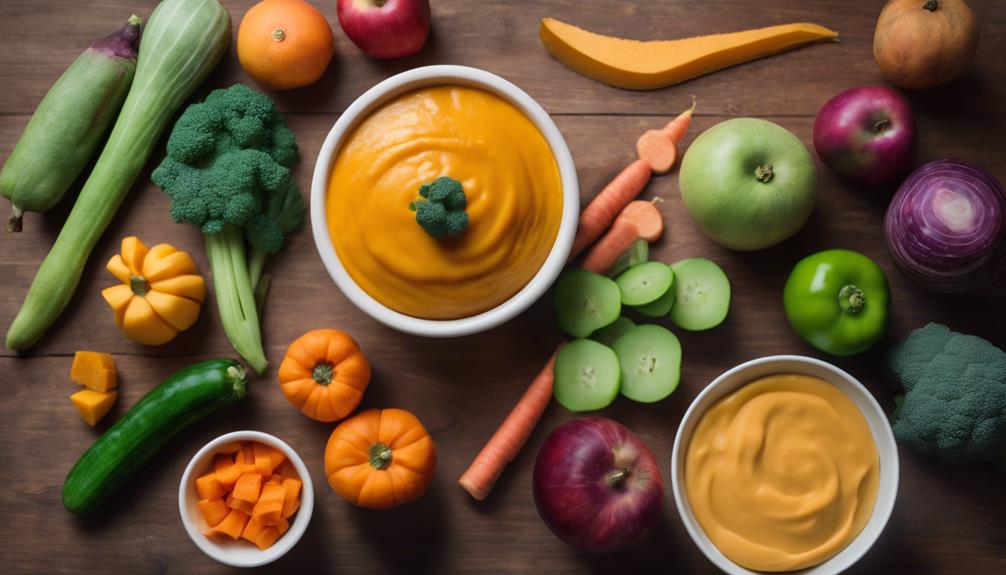
Explore exciting combinations for your baby's butternut squash puree to introduce a variety of flavors and nutrients into their meals. Butternut squash pairs beautifully with a range of fruits and veggies, making it versatile for your little one's palate.
Here are some delicious ideas to enhance your baby's butternut squash puree:
- Combine butternut squash with apples and pears for a sweet and nutritious twist.
- Add some spinach and kale to the mix for an extra boost of vitamins and minerals.
- Mix the butternut squash puree with pasta, rice, or baby cereals to offer different textures and flavors to your baby's meal.
Don't be afraid to get creative with your baby's food combinations; the possibilities are endless! Whether you're following traditional feeding methods or exploring baby-led weaning, incorporating butternut squash into your baby's diet can provide a variety of essential nutrients while keeping mealtime interesting and enjoyable.
Making Butternut Squash Puree

To make butternut squash puree, start by baking or steaming the squash until soft and then blending it until smooth. You can remove the skin by cutting the squash in half and scooping out the seeds after cooking. Achieve the desired consistency by blending the roasted squash with water, formula, or breast milk. Check out the table below for some quick tips on making and storing butternut squash puree for your little one.
| Steps to Make Butternut Squash Puree | Tips for Storage |
|---|---|
| 1. Bake or steam butternut squash until soft | – Store in the refrigerator for up to 3 days |
| 2. Remove skin and seeds | – Freeze in ice cube trays for up to 3 months |
| 3. Blend with water, formula, or breast milk | – Thaw frozen puree in the refrigerator before serving |
| 4. Store in airtight containers or freezer bags | – Label containers with date for easy tracking |
Making butternut squash puree at home is a simple and nutritious way to introduce your baby to solid foods. Enjoy the process of creating healthy meals for your little one!
Variety in Baby's Diet
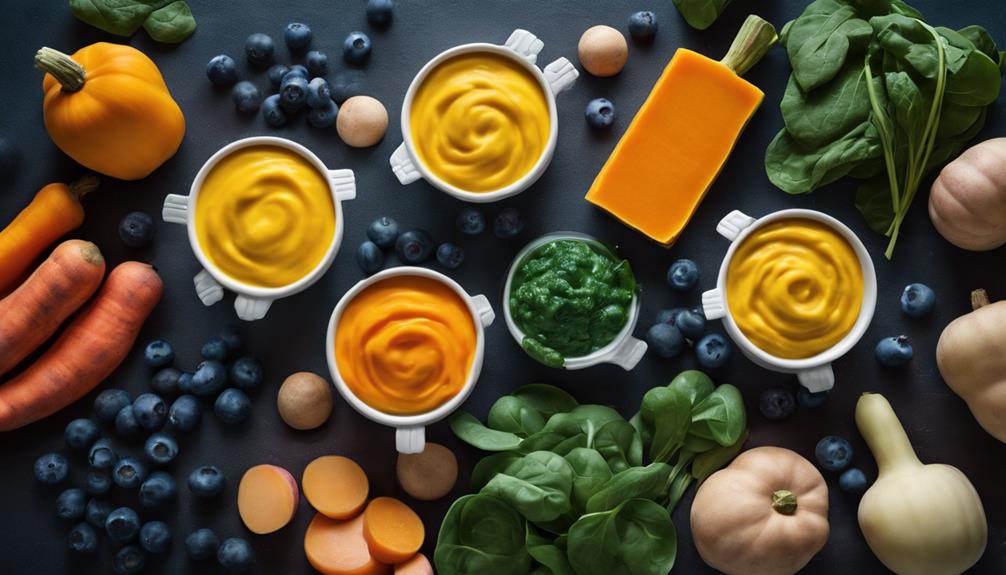
Improving your baby's diet with a variety of colorful vegetables is crucial for providing a broad spectrum of essential nutrients for their growth and development. By incorporating different veggies into your baby's meals, you can guarantee they receive a diverse intake of vitamins and minerals necessary for excellent health.
Here are some fun ways to introduce variety into your baby's diet:
- Mix and match different colored veggies like carrots, sweet potatoes, and peas to create visually appealing purees.
- Experiment with a combination of fruits and veggies to offer a balanced intake of nutrients that support your baby's overall well-being.
- Don't forget to include nutrient-rich options like butternut squash, which provides essential vitamins like beta-carotene for your little one's growth.
Butternut Squash Puree Recipe Details

For a flavorful and nutrient-packed baby food option, consider trying out the Butternut Squash Puree recipe featuring a blend of butternut squash, apples, carrots, and a touch of mild curry. This delicious combination provides a perfect balance of sweetness from the apples, earthiness from the squash, and a hint of warmth from the curry blend.
The inclusion of carrots adds a nutritious boost, making this puree a well-rounded choice for your little one.
This Butternut Squash Puree is ideal for babies aged 6+ months and yields approximately 20 ounces of nutritious baby food. With a high user rating averaging 4.87/5, this recipe has been praised for its taste, versatility, and adaptability for the whole family.
Storage is a breeze with options to keep it in the fridge for 3-4 days or freeze it for up to 4 months, ensuring convenient use whenever needed.
Consider serving this puree with chickpeas, peas, brown rice, spinach, white fish, or use it as a base for a delicious soup. Your baby will surely enjoy this wholesome and flavorful meal!
Frequently Asked Questions
What Flavors Go Well With Butternut?
You can pair butternut squash with sweet fruits like apples, pears, or bananas for a natural sweetness. For a savory twist, try combinations with carrots, sweet potatoes, or peas. Spices such as cinnamon, nutmeg, ginger, and curry add warmth and aroma.
Can Babies Eat Butternut Squash Every Day?
Yes, babies can eat butternut squash every day. It's a nutritious choice for their diet. Remember to introduce a variety of foods to guarantee balanced nutrition. Moderation and diversity are essential for your baby's healthy development and growth.
Is Butternut Squash a Stage 1 Baby Food?
Yes, butternut squash is a stage 1 baby food. It offers essential nutrients, a smooth texture, and mild flavor, making it a nutritious and gentle option for introducing solid foods to your little one.
What Are 3 Ways You Can Eat Butternut Squash?
You can enjoy butternut squash in various ways like roasting with herbs, adding to soups or salads, and using in baking recipes. Experiment with spices like cinnamon or curry powder for a flavorful twist.
Conclusion
With these delicious butternut squash baby puree combinations, your little one is sure to enjoy a nutritious and flavorful meal. So, go ahead and get creative in the kitchen!
Experiment with different ingredients and flavors to keep your baby excited about mealtime. The possibilities are endless, and the smiles on your baby's face will be priceless.
Happy cooking!

